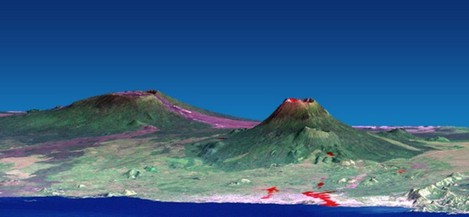|
Nyiragongo, famous for its almost constant lava lake within the summit crater, it is a stratovolcano of the Virunga Volcanic complex in the East African Rift Valley and is probably the most dangerous in Africa. In total there are 8 mountains in the complex however Nyiragongo and the nearby Nyamuragira (picture below) are the only ones which remain active today. The two most important and devastating eruptions of Nyiragongo occurred in 1977 and 2002, both of these eruptions caused many fatalities. The eruption in 1977 completely and rapidly drained the lava lake on the 10th January 1977 creating rapid lava flows (up to ~60 mph in some cases) this rapidly overwhelmed the flanks and displaced many people present in Goma and on the flanks of the volcano. The lava lake then began to refill and on January 17th 2002 another eruption occurred when a fissure initially propogated from the top of the volcano (and later from the base) allowing the outflow of lava, the length of fissures totalled almost 20 km. Lava fountaining (or Hawaiian activity) was also present during this eruption. Another youtube video gives an excellent overview of the area around Nyiragongo and the eruption of 2002, available here. Sources
Shuler and Ekström, 2009. Anomalous earthquakes associated with Nyiragongo Volcano: Observations and potential mechanisms. Journal of Volcanology and Geothermal Research 181 (3-4), pp. 219-230 Mavonga et al. 2010. Studies of crustal structure, seismic precursors to volcanic eruptions and earthquake hazard in the eastern provinces of the Democratic Republic of Congo. Journal of African Earth Sciences 58 (4), pp. 623-633 Global Volcanism Program John Seach Nasa EOS The question of whether there was active volcanism on Mercury has been disputed for decades, with scientists failing to produce working hypotheses for volcanism. The reason for this scepticism is that there were assumed to be a lack of volatiles beneath the surface of Mercury. Volatiles (such as CO, CO2, H2O, SO2, H2S) are needed for an eruption to become explosive, if these volatiles are allowed to exsolve from magma (via reduced pressure as magma rises) and are present in sufficient quantities, gas bubbles of volatiles can nucleate and the process of fragmentation can occur, which will give rise to explosive eruptions. Mercury has a low atmospheric pressure - close to 0 and at lower atmospheric pressures fewer volatiles are needed to create explosive eruptions. However it is not as simple as this, with some volatiles deemed as more 'important and efficient' when considering eruption processes. For example CO2 is less efficient as it tends to exsolve at greater depths, whilst H20 is the most efficient. For a number of reasons it is unlikely that H20 is present within the interior of Mercury. Any Mercurian eruptions are therefore likely to be smaller in size (Hawaiian, Strombolian, Vulcanian) or limited to effusive (non-explosive) eruptions. There are several theories as to which volatiles are present within the Mercurian inter
With the recent flybys of the MESSENGER probe interesting aspects of the surface have been definitively identified as volcanic in origin. Images of Mercury have shown evidence of a variety of volcanic features. Within the Caloris basin, wide and relatively flat shield volcanoes (comparable to the ones seen on the Moon) have been discussed by Kerber et al. (2009) with evidence of pyroclastic deposits surrounding one of these shield volcanoes. These formations provide more than just evidence of volcanism on Mercury but also that volatiles are (were) in existence within the interior. The pyroclastic deposits are hypothesised to have been formed by the equivalent of a Hawaiian lava fountain eruption. The shield volcanoes were formed by effusive volcanism in the form of lava flows. There is also further evidence of volcanism from satellite imagery in several of the Mercurian plains. Pit craters have been identified due to their steeper walls than the ones formed by impact craters. This provides some evidence of magma chambers, it is surmised that these features formed in a similar manner to caldera collapse on Earth. Mercury orbits the sun at an average of ~58 million km and has a radius of ~2400 km. With the entry into orbit of MESSENGER the volcanic history of Mercury will start to unravel! Still to look forward to over the next couple of weeks in my brief planetary volcanism discussions - Venus, Mars, Io and a discussion of cryo-volcanism! Journal articles read in relation to this topic and which may be of interest: Kerber et al. (2009). Explosive volcanic eruptions on Mercury: Eruption conditions, magma volatile content, and implications for interior volatile abundances. Earth and Planetary Science Letters 285, pp. 263–271 Head et al. (2009). Volcanism on Mercury: Evidence from the first MESSENGER flyby for extrusive and explosive activity and the volcanic origin of plains. Earth and Planetary Science Letters 285, pp. 227–242 Gillis-Davis et al. (2009). Pit-floor craters on Mercury: Evidence of near-surface igneous activity. Earth and Planetary Science Letters 285, pp. 243–250 In other volcano news, Etna is continuing its activity, with strombolian/hawaiian activity occurring over the past few days. Ruapehu (New Zealand) sustains its signs of unrest with increased CO2 degassing and maintained high crater lake temperatures. Its taken me a while to get up and running but will now hopefully start to post more regularly. |
Archives
August 2022
|


 RSS Feed
RSS Feed